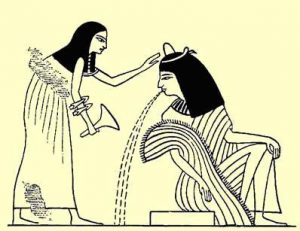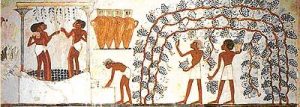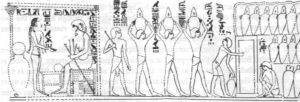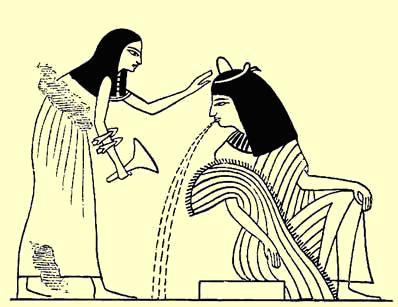by Mennat-Allah El Dorry
Wine has always been a glorified product in the ancient, as well as the modern, worlds. It was considered a food due to its nutritious content , and was used in medicine. Mixed with liquid medication, it provided a cover up to foul-tasting medications; it also was used as a mild antiseptic , as cough syrup , as an appetite-restorer , for quelling fevers, dressing wounds , and “releasing a child from the belly of a woman ,” i.e for sedating the woman in birth.
Wine production started very early on in the Egyptian civilisation. The first evidence of wine brewing appeared on the stoppers of wine jars from the Predynastic and Thinite periods . Large quantities of wine jars were discovered in the tombs of Early Dynastic nobles, signifying an early appreciation for wine, as well as its consumption by the upper classes for the most part . Like meat, wine was a valuable commodity and was mostly only found in festivals and on special occasions .
Unlike the common Egyptian’s domestically brewed beer, wine was made exclusively for royalty and elite, being brewed on special large-scale facilities primarily owned by the royal family . Early in Egyptian history, vineyards were only owned by well-to-do nobility due to the poor political and economical conditions . Owning a vineyard was very prestigious , and they were initially a luxury rather than an investment . Wine was mostly consumed at banquets and feasts. The lower classes got their share of wine during public feasts such as the feast of the harvest-goddess Renenutet, the festival of Hathor, and the Valley Festival. Wine was also given as rewards to soldiers . Workers from Deir El Median (West Bank of Thebes) could have possibly received wine bonuses, as there have been several wine labels recovered from garbage dumps (although it is not clear who in the village hierarchy would have received this wine, whether just the overseers, or any of the workers) .
Wine was commonly associated with divinity, and was believed to have divine qualities. According to Plutarch, who quoted Eudoxus, Egyptians thought wine was:
“The blood of those who had once battled against the gods, and from whom, when they had fallen and had become commingled with the earth, they believed vines to have sprung .”
This relates to the ancient Egyptian myth of the “Destruction of Mankind” where the goddess Hathor was sent by her father, Re, to destroy a group of conspirators, and when she became addicted to blood, and could not be stopped from bloodshed, she was tricked into drinking a red coloured drink instead of blood , often believed to have been red wine. Wine was also considered the drink of the gods .
Most of what we know about winemaking and vintage comes from seal-inscriptions on wine jars, tomb depictions or textual sources, as well as chemical analysis on jars that once had wine. Sealing inscriptions show that each vineyard had its unique name, most of them having religious associations, such as Horus Dja meaning “the Beverage of Horus .” However, the most informative source is tomb paintings that show the steps followed in winemaking. Twelve distinctive elements can be identified in most tombs, but not necessarily always depicted together in the same tomb, or even the same period . These scenes cover the most important steps starting from the harvesting and treading to the bottling, storing, and even the excessive consumption (figure 1).
. 
figure 1
These depictions of the steps of winemaking were never intended as a guideline for winemaking, and many of the artists who drew the scenery probably never witnessed it for themselves, rather blindly copying the scenes from one tomb to another. The scenes drawn are only the major steps of winemaking, many intermediary steps not being depicted at all, and there is also no time indicator. We know from tomb depictions with remaining colours that the Egyptians had white, pink, green, red, and dark blue grapes . Ancient Egyptian wine was not only made of grapes, but fruits such as figs, pomegranates, dates, figs, and palm. The method of making various fruits into wine is not known, but is essentially the same as that of grapes, but sugars were added to help their fermentation .
Viticulture is a sign of a higher degree of civilisation, as it required abundant resources and labourers. It required much irrigation, which took up most of the labourer’s time . Vineyards were generally planted on an elevated plane, whether natural (like hills) or artificial. Wall paintings show that vineyards were surrounded by a stone or clay walls, and often had a large water basin. Vines were trained on trellises which were often resting upon rows of large decorated columns placed far enough from one another to allow easy passage of labourers, yet were close enough to prevent much sunlight entering, threatening the moisture of the crops . Great care was exercised to protect the grapes from birds , labourers often scaring them away . The 100 days before the harvest are the most important; they make the difference between good quality “nefer nefer nefer ” wine and lesser “nefer” wine .
With that taken care of, labourers would do the following:
1. Harvesting: One of the most popular scenes depicted in tombs is that of wine harvesting (figure2).

figure2
The exact timing would have varied annually in ancient Egypt, but usually would have occurred in late summer . If tended well, all the grapes would ripen well at the same time . While mostly males are depicted in the scenes, women and children must have participated in this task . Grapes were cut by hand, not knives , and placed in deep wicker baskets carried by men on their heads, shoulders, or balance by a large stick with a basket at each end across the labourer’s shoulders (figure3) .

figure3
Scenes show the grapes being covered by vine leaves, foliage or palm leaves on their way to the press probably protecting them form the sun .
2. Treading: Grapes were placed into large vats after harvesting. It is shown in tomb paintings from the New Kingdom that these vats were round in shape, which possibly was the same shape for the previous times . The material with which the vats could have been made is a debated topic, but hard stones (granite or schist) seem to be the material used in vats since they were waterproof, and easy to clean . The traditional method throughout the Mediterranean and the Near East for pressing grapes was by treading underfoot. This was probably gentler than a stone press, which crushed the stems and seeds, adding bitterness to the wine . At least four men could fit into the vats, and several tombs paintings show five or six men standing in these vats .
Vats were placed on a slight elevation, and were very often covered with a roof that has ropes, which the men held onto as they pressed the grapes with their feet (figures 3 and 4).
. 
figure4
Men would hold onto poles at the edges of the vats if there was no roof, the men in the middle holding one another’s hips (figure4). Wine pressing was accompanied by singing and the playing of instruments, the rhythm kept by the females . In the New Kingdom there appears to be no instruments, yet one of the males is often depicted singing, with a song dedicated to the harvest-goddess Renenutet is written above . The wine juice flowed though a drain into smaller vats where the wine was fermented (figure3)
3. Pressing: A second pressing was required to extract the juice remaining juice form the grapes. Placed in an oblong linen slough, wine-lees were squeezed by stretching the linen across a strong wooden frame; with men on one side twist the linen . The squeezed liquid would flow into a pot placed underneath the slough. This required four persons, while a fifth was often depicted horizontally on the slough (figure4). This was probably an artistic amendment or the artists’ lack of wine-pressing knowledge, in reality the fifth man would be standing behind the pressing making sure the wine flowed straight into the trough , in which it was left to ferment . There were several grades of wine must . “Free Run must” was obtained from the grapes’ own weight, and little of this was collected. It produces long lasting very sweet wine . “First Run Must” comes from treading, which is around two-thirds of the total juice, and “Second Run Must” is produced in the additional pressing . There is no indication as to whether different grade juices were mixed. Mixing the different grades would have lead to different kinds of wine, whether red, white, sweet, or dry .
4. Fermentation: Fermentation is converting the sugar in the grapes into alcohol. This occurs when the enzymes in the sugar are exposed to the natural yeast in the skins, stalks, and seeds . The level of alcohol varies with the amount of sugar . Fermentation stops when the alcohol level reaches to around 14% or 15%, the remaining sugar adding sweetness to the wine . Duration of fermentation varies depending on the required consistency. Wine fermented for a few days produced a light final product, while one that is kept for several weeks, possibly heated , produced a very heavy beverage. The stalks, seeds, and skins would have probably been left in the wine must for long periods to give a richer colour and bitterness (especially so for red or “black” grapes) . The difference between red and white wine would not have only varied with the using of white or darker grapes, but whether or not the skins were left in for fermentation . Wine would then be filtered through a piece of linen and bottled.
5. Bottling and Sealing: Wine was poured into short but wide necked jars – or skins if they were to be taken on long journeys . Bottling was done immediately after fermentation. The wine was placed in jars with coned bases (to collect dregs if the wine continues to ferment after it is placed in storage ). Wine would have been sealed a few days before the fermentation reached vinegar. Reeds, straws, and/or pottery would be placed as a stopper, which protected the wine flavour from being affected by the mud used in the final sealing . Using straw to seal the jars or leaving a hole (which was closed before storing) in the stopper let out the carbon dioxide that accumulated during fermentation .
6. Labelling and Storing: After the sealing, the wet mud was stamped with the information about the wine, or ostraca (limestone, faience, or pottery – which were handwritten) were used. Information included the regnal year, name of the vineyard, name of the wine maker and often the quality of the wine . The wine was inspected by special officers or “inspectors of the wine” (figure5)

figure5
The wine jars were counted by a scribe as they were placed in storage. The jars were placed on wood or stone stands, or resting on the ground in successive rows, with the wine farthest back being the oldest (figure5)
There were several kinds of wine in ancient Egypt known from offering lists in tombs, such as Irep mehu (Lower Egyptian wine or of the Marshes - the Delta being one of the largest winemaking centres of ancient Egypt), Irep Bes (wine in an Abesh jar), Irep Imit (wine of Imit – north of Faqous ), and Irep Dedjem (sweet wine). Sweet wines usually have a higher alcoholic content because most of the sugar turns into alcohol, and they last longer . Wine was sweetened by adding dried fruits or honey, which often caused the wine to re-ferment . Sometimes very ripe grapes, slightly dried, were used in wine because they had a higher concentrate of sugar; adding a sweeter flavour to the wine and making it last longer . While little is known of blended wines, it is known that they existed in ancient Egypt. They would have been mixed shortly before consumption.
Works Cited
Harris, Geraldine. Gods and Pharaohs from Egyptian Mythology. Italy: 1982, Eurobook Limited.
Lesko, Leonard. King Tutankhamun’s Cellar. Berkley: B.C. Scribe Publications, 1978.
Lutz, H.F. Viticulture and Brewing in the Ancient Orient. Leipzig: J.C. Hinrichs, 1922.
McGovern, Patrick E and Stuart Fleming and Solomon H. Katz, eds. The Origins and
Ancient History of Wine. The Netherlands: Gordon and Breach Publishers, 1996.
Montet, Pierre. Everyday life in Egypt in the Days of Ramesses the Great. Philadelphia: University of Pennsylvania Press, 1981
Murray, Mary Anne. “Viticulture and Wine Production.” In Nicholson, P., and Ian Shaw (eds.). Ancient Egyptian Materials and Technology. Cambridge: Cambridge University Press, 2000
Nunn, J.F. Ancient Egyptian Medicine. London: BMP, 1996
Poo, Mu-Choo. Wine and Wine Offering in the Religion of Ancient Egypt. Columbia: Columbia University Press, 1995.




